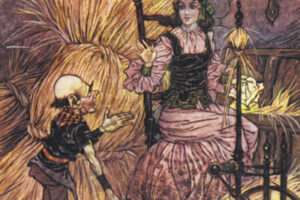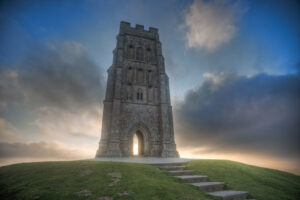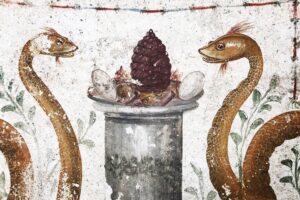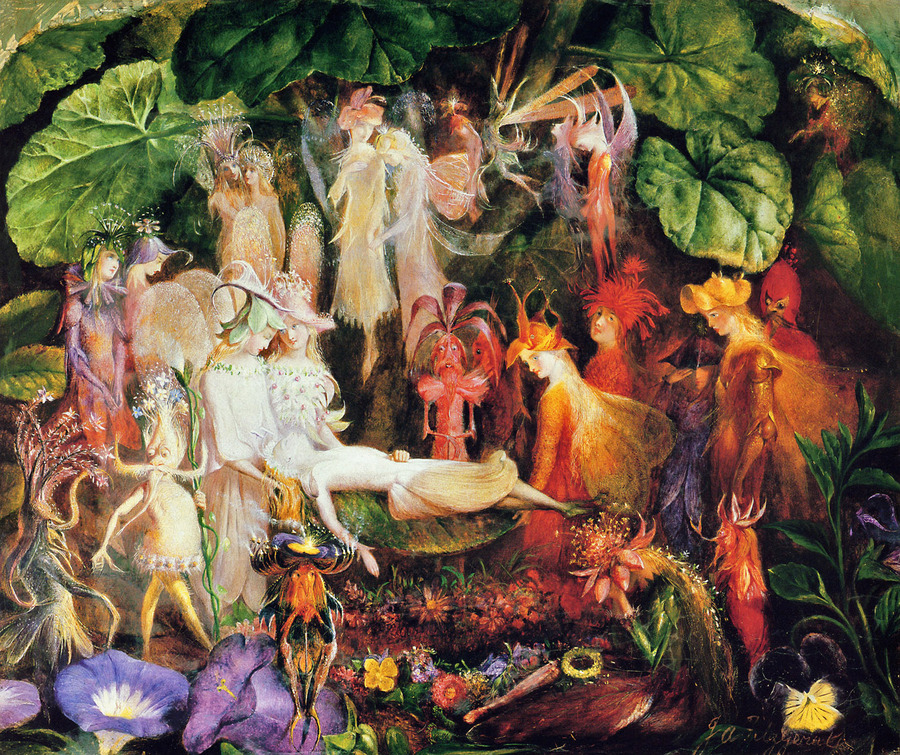
From Nature’s spirit cult to Christianity
From Nature’s spirit cult to Christianity
by Hasan Andrea Abou Saida
The Italic peninsula has always been rich in legends, traditions and myths of the foundation of cities by divinities, genies or spirits of Nature. From ancient origins, the cult of the natural spirits, also known as the “Little People”, has always been deeply felt by our Italic ancestors and was an integral and fundamental part of their spirituality. The deep and archaic relationship between our ancestors and the elemental spirits of Nature has, over the centuries, been lost and almost forgotten, leaving few but indelible traces of the presence of the natural spirits in their successors, such as the Greek and Roman deities and finally in the Christian cult. Popular traditions, fairy tales and myths help curious souls to unravel this magical reality, populated by fairies, gnomes, elves, sylphs, dwarves, nymphs, sirens, trolls, genies, dryads, fauns, and many other spirits that are part of the “Little People”. These elemental beings are spirits that create and help life, and each is a manifestation of one of the four natural elements (earth, air, fire, water). Each spirit governs and is present in every spring, mountain, waterfall, river, plain, wind and many other elements of Nature, and their existence is concealed but present and renewed in Christian worship today.
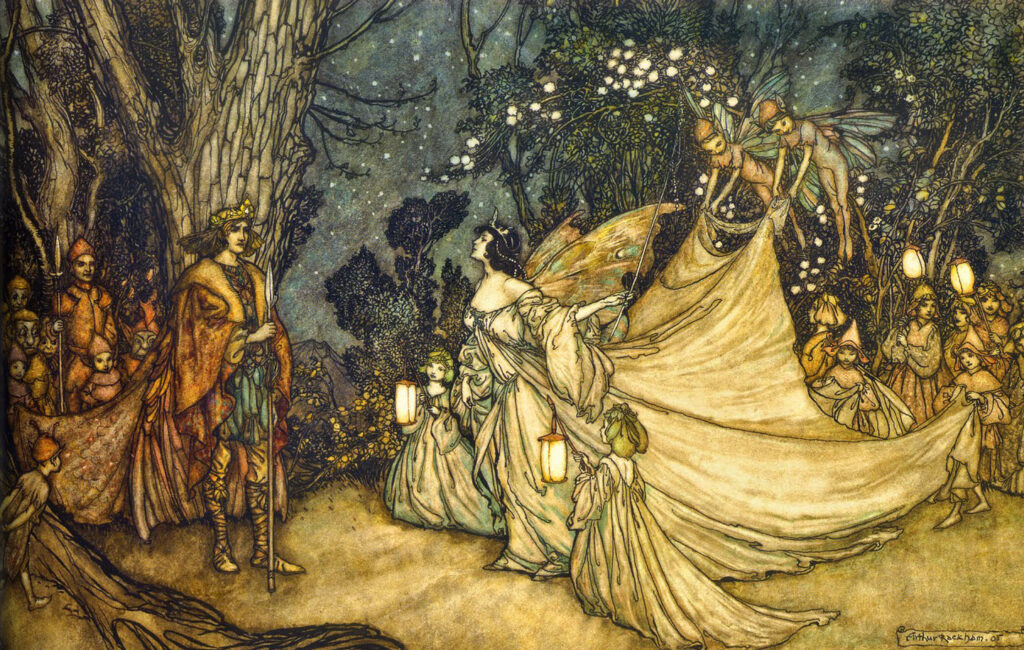
Among the most important Italic deities that predate the Roman cult is Feronia, an ancient rural Italic goddess. Her cult has been extensively documented among the Etruscans, Umbrians, Picenes, Sabines and Volscians, and she was worshipped as the patron goddess of the woods and the harvest. Legends and folklore speak of her as a woodland fairy, mother of Erulus, protector of spring waters and personification of the eternal spring. Excavations at the sanctuary of Lucus Feroniae have established certain characteristics of the goddess Feronia, such as Salus (health) and Frugifera (fertile) 1.
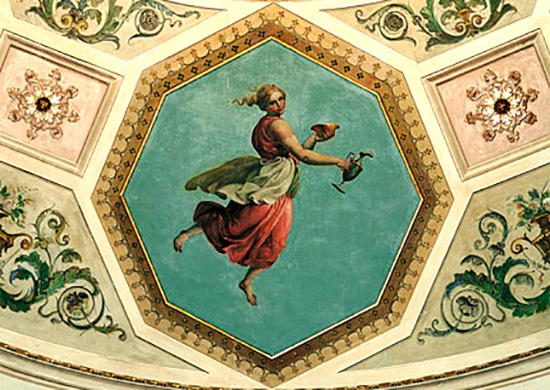
In Narni there is an ancient pre-Roman spring dedicated to the goddess Feronia, dating back to the 6th century BC. The sacred spring of the ancient Nequinati was once surrounded by a wood of shady elm trees, and attached to it was a temple and a statue of the goddess Feronia. Since ancient times, it has been a place of pilgrimage in honour of the goddess and the sacred therapeutic virtues of her spring. Roman mythology then transformed the wood fairy into a goddess protector of freed slaves and of everything that grows underground and comes out into the sunlight. Feronia became the Lady of Fairs, a Nature Goddess just like the Ephesian Diana with numerous breasts and beasts depicted on her robe. Later, the first Christians of Narni pulled down the temple and destroyed the sacred wood, which from that moment on was called macchia morta, i.e. not existing. In 1851, the Narni historian Giovanni Eroli commissioned the University of Perugia to analyse the water in the spring, which returned the following answer: “Feronia’s water is rightly considered to be one of the most reputable drinking waters, since it meets the main requirements that drinking water must have, i.e. it contains a lot of oxygen and very little of other dissolving substances”. The Feronia spring therefore remained intact, and thanks to the lightness, goodness and therapeutic virtues of its water, it became a favourite among the inhabitants compared to other springs 2.
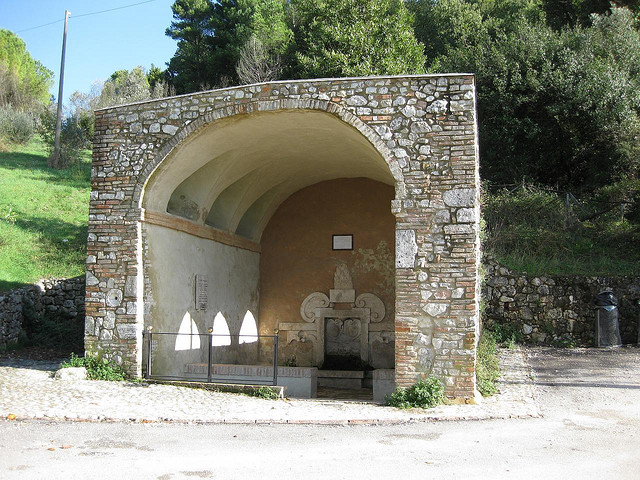
The myths and folklore of the Alpine arc also tell us of the existence of the Aquane cult linked to the prehistoric rock art of Valcamonica in Lombardy. The place-name Naquane, where the National Park of rock engravings is located, seems to be a modern ‘corruption’ of the name used until a few years ago, which was Aquane, a dwelling place for spirits linked to water and earth, very similar to mermaids. Although there is a definite connection also in Valcamonica between petroglyphs and watercourses, in Naquane, which has no streams, this connection exists because the rocks, smoothed by prehistoric glaciers, look like large stone waves. In addition, glaciers have sometimes created small cavities, pools in which water remains 3. Further north, in the area of the rock engravings at Ceto, the toponymic memory of the Aquane persists: from a vast area at Foppe di Nadro below rock 30, already marked as a Chalcolithic women’s place of worship (Pre delle Aquane), along the Aquane road, as far as Casa Aquane and the Aquane district, the whole area is linked to the memory of these divine beings whose presence is attested throughout the Alps 4.
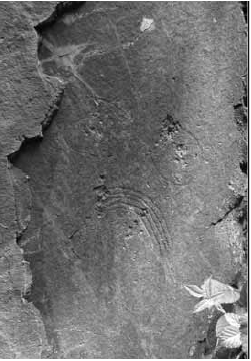
The Aquanas are depicted in popular tradition as anthropozoomorphic deities, protectors of the valley, linked to water and earth. They lived in lakes, springs and caves from which they rarely appeared. They possessed the gift of knowing the past and the future and had absolute dominion over water, both running and rainwater. Accompanied by snakes and water birds, they practised the art of weaving and are also known to be counsellors of youth, i.e. linked to rites of passage. Rock No. 1 at Naquane has seven looms engraved on it, and it is the only place where looms are found in rock art in Valcamonica.
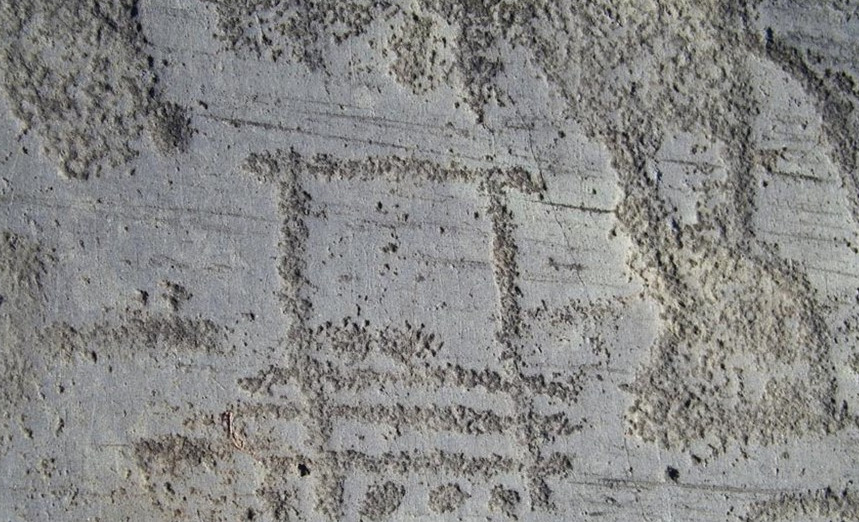
The presence of female cults in Valcamonica is attested as early as the Early Copper Age at Sellero, north of Capo di Ponte, where an articulated composition of topographical elements revolves around a female idol, recognisable by the presence of breasts covered by a sort of line ornament. In Breno, in the locality of Spinera near the river Oglio, on a plain with caves and spring water, an open-air sacred area was built with a ceremonial enclosure and altars, where cult practices took place with the lighting of votive pyres (brandöpferplätze). Among the various cult objects found, there is a pendant depicting a female anthropomorphic figure in a praying attitude on a solar boat with a double ornithomorphic protome. These elements confirm the aquatic nature of the deity in question, assimilating her to an Aquana, linked to waterways, fords and rites of passage. Many of the votive objects found, datable from the 5th to the 2nd century BC, can be compared in a similar way with some found in Veneto and Trentino dedicated to the very ancient Euganean goddesses Reitia and Pora, connected to water and weaving, and even earlier to creatures called Anguane 5.
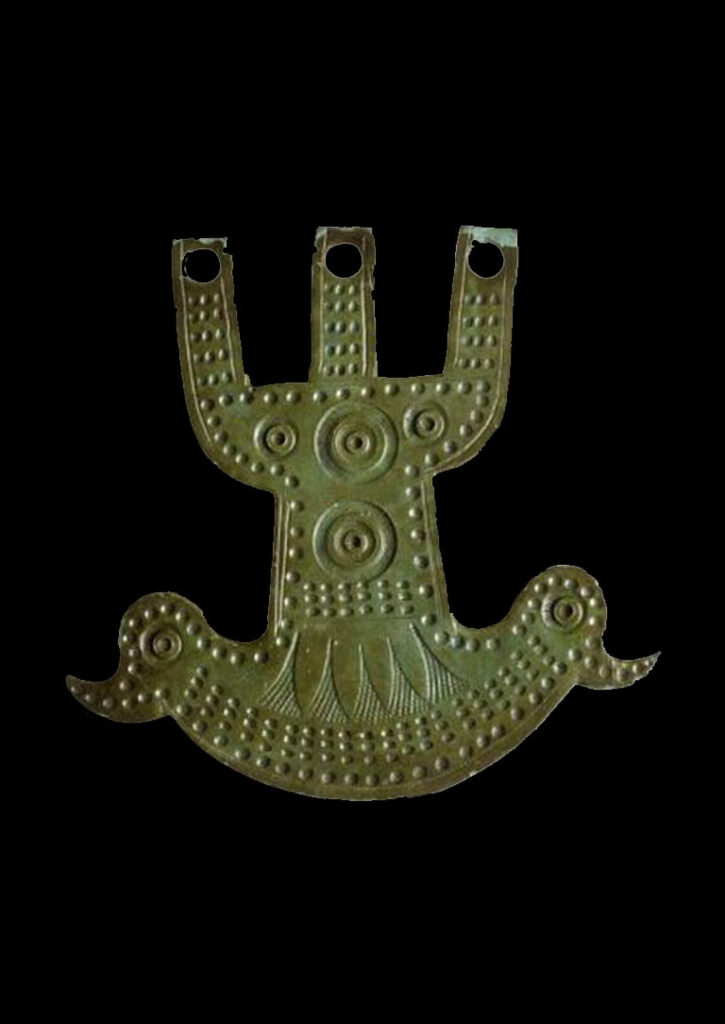
According to De Marinis in “La cultura Breno-Dos dell’Arca e il problema degli Euganei”, the name of the Euganeans, belonging to the same ethnic group as the Iron Age Camuni, is also related to the Eguane or Enguane variant. According to popular etymology, the lexeme anguana, by which the Aquanei are generally known in the Veneto, derives from the popular Latin aquana: a sort of crasis between the Latin words aqua (water) and anguis (snake). According to Veneto legends, anguanas live in caves near springs and streams and can be seen at dawn and dusk. Anguane guard treasures, can predict the future, like sibyls, and know the past but not the present. They lure human beings into the kingdom of shadows and make them lose their sense of time 6. The archaic cult of Aquane in the Camonica area is also found in Borno, with the continuation in Roman times of a female cult linked to water and rites or places of passage, interpreted by the goddess Minerva. Already present in the 5th century B.C. and Romanised in the 1st century B.C., there was a sanctuary in the Spinera area in Breno dedicated to Minerva, the patron goddess of fertility, the family, the territory and also of the arts requiring technique, knowledge and memory. In continuity with the protohistoric phase, there is always a strong relationship between the Roman goddess and spring water. The sanctuary stands against a rocky spur on the banks of the River Oglio, opposite a natural cave in which a spring with miraculous and thaumaturgical properties gushed forth. In the 4th century A.D., the process of Christianization undergone by the valley led to the progressive abandonment of the cult of Minerva and consequently of the sanctuary, which in the following century was finally destroyed by a violent fire and was soon forgotten. Only the toponymy preserved the ancient tutelary divinity of the sanctuary, so much so that the bridge of Manervio near Breno is mentioned as early as in the Vita di Sant’Obizio (12th century). The memory of the ancient cult had therefore found a place a little further north, near the bridge crossing the River Oglio: in the area bordering two or three districts, with spring water, a first chapel was built between the 13th and 14th centuries dedicated to the Virgin Mary, protector of the territory and the faithful. The church, richly frescoed between the 16th and 18th centuries, offers a varied iconographic programme almost exclusively centred on the Virgin, presented from birth to Coronation and with very few Christological references, confirming the pre-existing cult of the goddess Minerva 7.
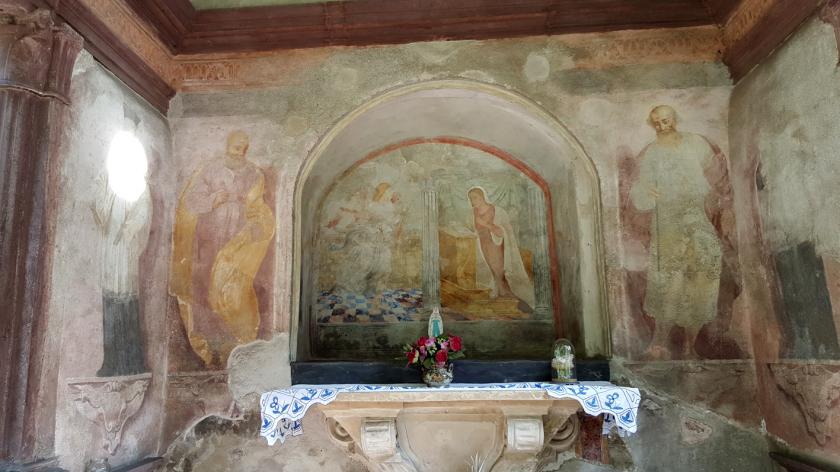
Another place of Christian worship that has taken up the pre-existing devotion to the Aquan deities is the church of Saints Faustina and Liberata, built next to the remains of a pre-existing Romanesque structure. The cult of Faustina and Liberata, non-local figures but the object of a very lively popular devotion, is linked to caves, water and protection during childbirth. The saints are said to have appeared during a flood to save the people of the village of Serio who had taken refuge in the church while the village was being swept away and destroyed in the 14th century. A stream, the Re torrent, flows near the church. The cult is documented only in Capo di Ponte, an element that leads some to hypothesize that the consecration of the church was wanted by a cultured local personality interested in preserving the continuity of the pagan cult, a person who would have gone so far as to commission furnishings and decorations that would unequivocally recall the world of water and sirens, as well as figures such as the Sibyls, therefore connected to the world of divination, as are the Aquane themselves 8.
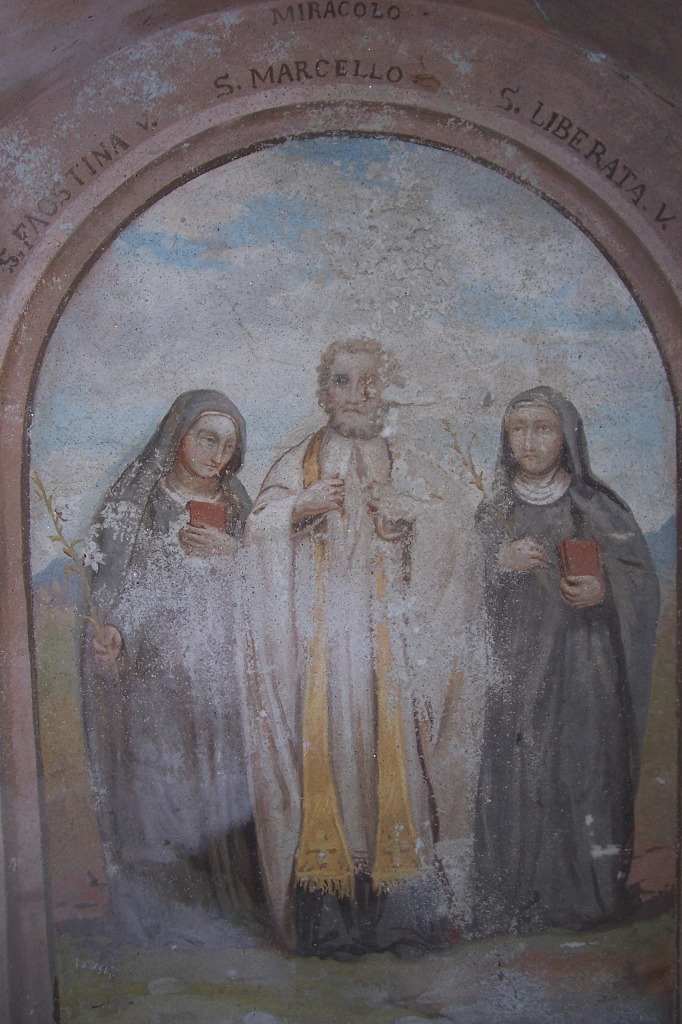
The same phenomenon can be found in Campania, especially in the ancient Greek colonies of Capri, Sorrento and, in general, on the eastern side of the Gulf of Naples. In fact, the whole of Campania has its origins in legend and in cults dedicated to the sirens. According to Pliny the Elder, the Bay of Ieranto was the meeting place between Ulysses and the three siren sisters who lived in the Gulf of Salerno, namely Partenope, Leucosia and Ligea. Their song was a subtle and persuasive means of seduction, linking love and death. They waited for ships to attract sailors who, captivated by their song, would crash their ships on the rocks, then be killed by the sirens. Ulysses, who was tied to the ship, was not seduced by the sirens’ song and the ship continued on its journey. After passing through, the three sirens, humiliated and irritated, threw themselves into the sea and killed themselves. Their bodies arrived in different places: Partenope, whose name the Neapolitans still keep today, arrived on the islet of Megaride, where Castel dell’Ovo stands today. Leucosia arrived in Cilento, while Ligea arrived in Calabria. The city, which was later called Neàpolis (Naples), was originally called Partenope in honour of the mermaid, who became the city’s patron goddess 9.
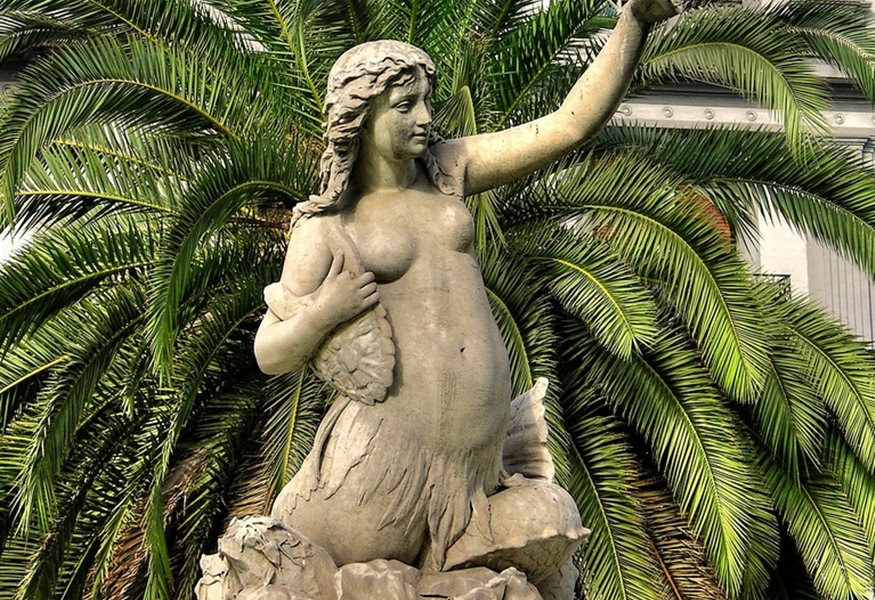
Having become a Greek colony, the Bay of Ieranto was consecrated by the Greeks to the goddess Athena, the Greek continuation of the cult of the watery female elementals. In fact, Athena had snakes as her divine attributes, and was referred to in some of the Orphic poems as ‘La Serpentina’. The serpent symbolises the ctonic powers of Mother Earth, but also the transformative energy associated with rivers, springs and streams. It is the lord of both the earth and the waters that tend to rise from the depths to the surface. On the shield of the goddess Athena was in fact placed the head of Medusa, a beautiful priestess of the same goddess who was transformed into a monstrous creature with serpentine hair capable of petrifying anyone who looked into her eyes. In times of anger or in battle, the goddess Athena took on the terrifying appearance of Medusa, transforming herself into a serpent-goddess. Later in Roman times, the temple of Ieranto was dedicated to the goddess Minerva and, with the arrival of Christianity, the place was consecrated to the Marian cult 10.
The foundation of the coastal town of Amalfi is also linked to an elemental spirit: legend has it that the demigod Hercules fell in love with a nymph named Amalfi, but she died suddenly, leaving the hero in terrible pain. Hercules travelled all over the world looking for a place to bury his beloved Amalfi, finding it on the rugged coast of Campania where he decided to stop and give rest to his nymph, christening the place Amalfi in his honour 11.
In Sicily there is a legend about the mythical origins of the island by three nymphs: it is said that three young girls, between one dance and another, travelled the world collecting particular fruits, seeds, pieces of earth and stones from the main fertile land. One day they came to a sunny land with a clear blue sky, where they decided to throw everything they had collected. After the launch, the three promontories of Cape Peloro to the north-east, Cape Passero to the south-east and Cape Lilybaeum to the west began to take shape, while from the waves of the sea, illuminated by a radiant rainbow, emerged a land in the shape of an inverted triangle, rich in natural resources and with a mild climate: Sicily. The island’s ancient name Trinàcria (Greek Trinakría; Latin Trinacria) referred explicitly to its three cusps.
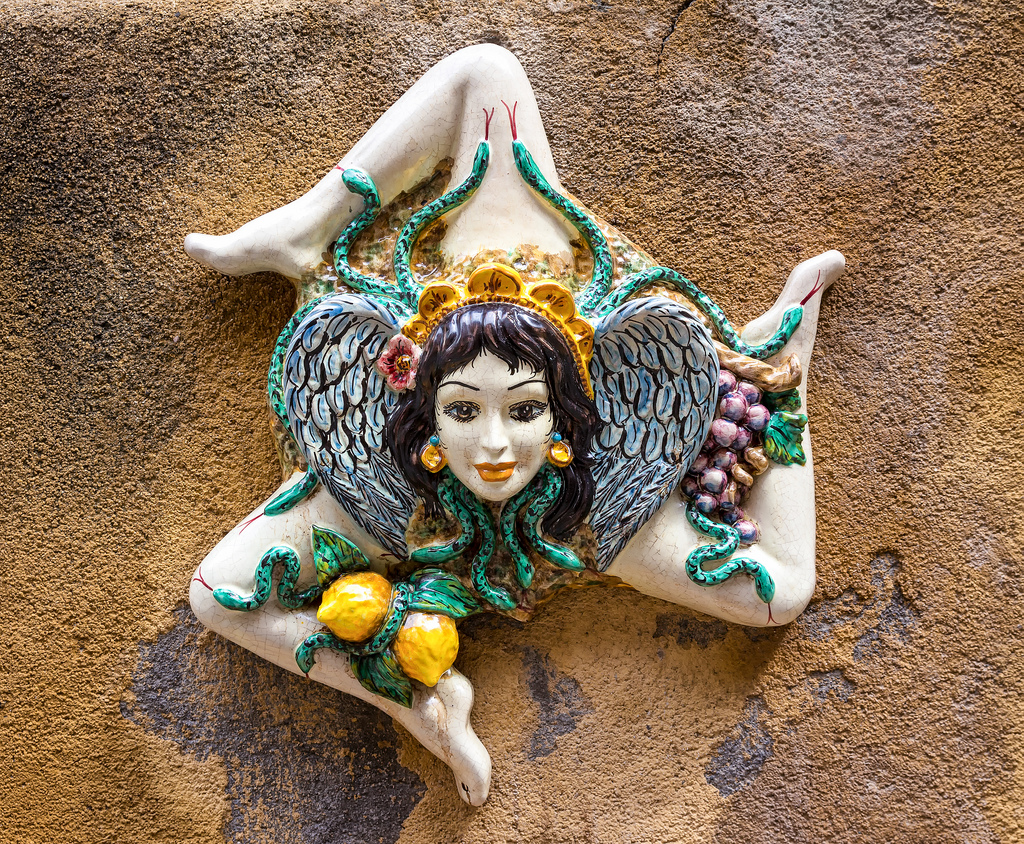
From the historian Timaeus, a Greek from Sicily, we know that it was customary on the island, and perhaps particularly in Syracuse, to offer sacrifices to the nymphs, in an all-night festival of dancing and drinking, from house to house and around the sacred images of the goddesses. One of the most famous nymphs in Sicily is undoubtedly Arethusa, a spring of water from the Monti Iblei close to the sea, along the west coast of the island of Ortigia. The freshwater spring was already important to the Siculians who, according to the accounts of Hesychius and Stephen Byzantine, called it Kypara, an archaic Sicilian water goddess who later took the name Arethusa in Greek times. In Ovid’s story, Arethusa is a nymph from Achaia who hunts and spends her days in the forests. One day, in order to recover from her hunting efforts, Arethusa bathes naked in the waters of the river Alphaeus, the main river of Ilia, which also flows past the sanctuary of Olympia; the river god falls in love with her and pursues her. Artemis’ intervention saves Arethusa from the violence of Alfeo; the nymph, wrapped in a thick cloud, dissolves in water and, sinking into the chasms of the earth, re-emerges in Ortigia. The river god, leaving behind the human aspect he had taken, becomes water again and merges with the reluctant Arethusa 12.
1 Ferrari, A. (2015). Dizionario di mitologia greca e latina. Torino: UTET, p. 327.
2 Monacchi, D. L’acqua come oggetto di culto e come servizio pubblico in età romana, http://utecnarni.altervista.org/fonte-feronia-e-la-formina/ (last visit 21/04/2021).
3 Busatta, Sandra. (2019). L’arte rupestre camuna tra Cervi, Caccia Selvaggia, Aquane e Nani minatori. 17-63.
4 Gastaldi, C., & Gavaldo, S. Sulle orme della dea. Antichi culti e santuari femminili nella media Valcamonica: alcune considerazioni. Santuàrios, https://www.ccsp.it/web/santuarios2016/programma e pdf vari/pdf_articoli/gastaldi gavaldo.pdf (last visit 21/04/2021).
5 Ibidem
6 Busatta, Sandra. (2019). L’arte rupestre camuna tra Cervi, Caccia Selvaggia, Aquane e Nani minatori. 17-63.
7 Gastaldi, C., & Gavaldo, S. Sulle orme della dea. Antichi culti e santuari femminili nella media Valcamonica: alcune considerazioni. Santuàrios, https://www.ccsp.it/web/santuarios2016/programma e pdf vari/pdf_articoli/gastaldi gavaldo.pdf (last visit 21/04/2021).
8 Ibidem
9 Così cantava Parthenope: la leggenda di Napoli. Ecampania, https://ecampania.it/event/cos-cantava-parthenope-leggenda-napoli/ (last visit 21/04/2021).
10 Casaburi, L. Baia di Ieranto, il Tempio delle Sirene. RicercAttiva Turismo, https://turismo.ricercattiva.it/baia-di-ieranto-il-tempio-delle-sirene/ (last visit 21/04/2021).
11 Casaburi, L. Le origini di Amalfi, la leggenda della ninfa e di Ercole. RicercAttiva Turismo, https://turismo.ricercattiva.it/le-origini-di-amalfi-la-leggenda-della-ninfa-e-di-ercole/ (last visit 21/04/2021).
12 Giacobello, F., & Schirripa, P. (2019). Ninfe: nel mito e nella città dalla Grecia a Roma. Milano: Viennepierre, pp. 133 – 150.

